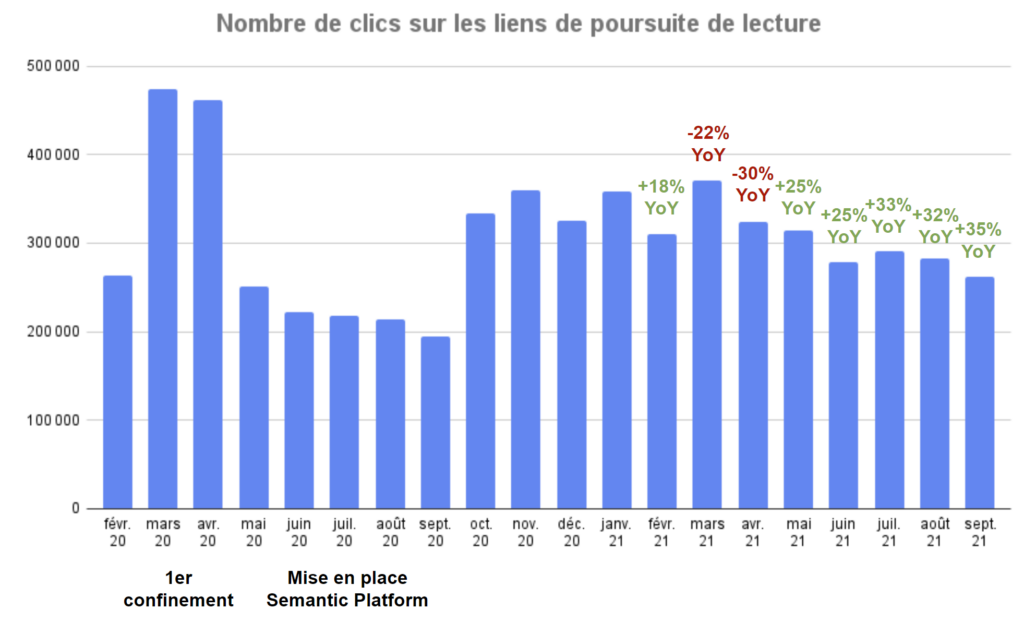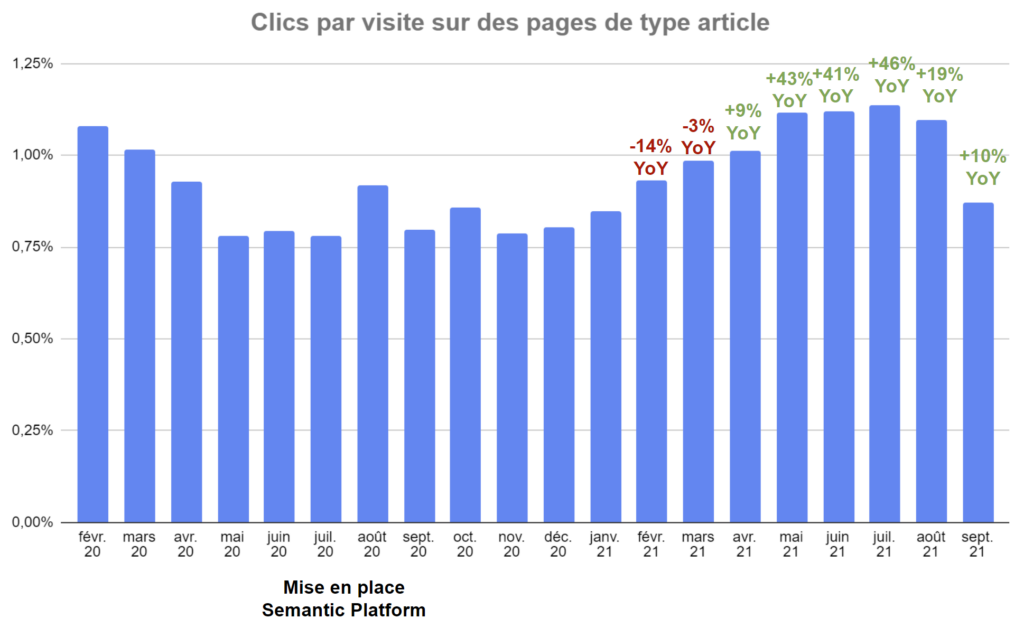Semantic Platform for Le Point: measuring website internal linking and engagement after one year of use
Introduction
Our Semantic Platform semantic enrichment solution is now used by a dozen news publishers toimprove their website's natural indexing andincrease the number of page views.
Semantic Platform's first client, Le Point, has been using the solution in production since September 2020, which now allows us to get concrete feedback on SEO statistics and user behaviour on the website.
During the Presse au Futur trade fair, Le Point agreed to communicate certain data which we present and explain in this article.
First of all, let's remember that the semantic enrichment proposed by our Semantic Platform solution aims to :
- improve the website internal linking (reduce the number of clicks needed to reach all the articles on the website) so that search engines index the website more regularly: a good linking reduces the indexing effort needed
- encourage readers to consult more articles via more extensive and qualitative follow-on links and via page tags on key words in the content
The use of Semantic Platform at Le Point
Le Point uses Semantic Platform to offer journalists, in their editorial tool :
- more like this links on the same subject as the article that was written (insert The Editor advises you):

- keywords for places, people and organisations detected in the text of the article, in order to lead to tag-pages (keywords underlined in dotted line)

The solution went live in the summer of 2020 and has been fully used by the editorial staff since September 2020.
Website internal linking
The internal linking of a website is classically represented in the form of a graph with the number of clicks on the abscissa and the number of pages reached via this number of clicks on the ordinate.
The graph below shows the internal linking of a news website for which we have carried out an SEO audit, which clearly shows the need to improve it:

The statistics have been transposed on the basis of a total number of 100,000 pages
It can be seen that :
- it takes 8 clicks (the first level is the home page) to reach the depth level which contains the most articles
- you have to reach the 7th level to have gone through half the pages of the website
It is clear that this internal linking is not optimal, both for the search engines, which wish to save their indexing efforts, and for the website reader, who is not helped to discover the publisher's entire editorial heritage!
In our experience, a number of news websites are currently in this situation.
Let's move on to the current internal linking of lepoint.fr website, after more than a year of using the Semantic Platform:

Statistics have been transposed on the basis of a total number of 100,000 pages
This time we find that :
- only 4 clicks (the first level is the home page) are needed to reach the level of depth that contains the most articles
- you only need to reach the 4th level to have gone through half the pages of the website
- 86% of the website pages are reached at the 4th level of depth
This linkage is optimal, both for the search engines, which will come and index the website more often, and for the reader, provided that the links proposed are qualitative, which we will study next!
Consultation of articles in the process of being read
We were able to obtain two interesting statistics to evaluate the relevance of the links proposed by Semantic Platform on the lepoint.fr website:
- the number of clicks on more like this links, following the reading of an article
- the % of clicks to article pages (follow-on links and keywords in the text), following consultation of a page
This graph shows the first history:

YoY = Year over Year, the % represents the evolution compared to the same month of the previous year
It can be seen that :
- March and April are down as they are compared to the 1st containment (which led to over-visiting and over-engagement across the online news sector)
- excluding these 2 particular months, the number of clicks increases between 18 and 35%.
It can be deduced from this that readers appreciate the follow-on links offered in the Editor's Tip box and therefore that Semantic Platform offers relevant articles as a result of reading an article.
This graph shows the second history:

YoY = Year over Year, the % represents the evolution compared to the same month of the previous year
It can be seen that, apart from the anomaly linked to the 1st containment, the % of clicks per visit increases between 9 and 46%.
This suggests that the various links to other articles (underlined keywords in the text and more like this links) encourage readers to read more articles.
Conclusion
We have already had very positive feedback on the use of the solution by the editorial staff of Le Point, who appreciate the time saved and the quality of the detection of keywords andpre-created the relevance of more like this links.
After just over a year of using the Semantic Platform at Le Point, we are now able to measure the concrete impact of the solution on the website internal linking and user behaviour.
Below are a few verbatims from the intervention of Olivier Bost, IT and Industrial Director of Le Point, during the workshop:
- "On SEO, we have noticed that we have more crawls on our pages by Google and we get more page views.
- "We also see it, in a very objective way, in the website logs, we have a tool called Botify, which allows us to have a vision of how Google sees the website and clearly in these Botify logs, we see that Google's passage has changed.
- "With artificial intelligence, we are guaranteed to have a semantically coherent reading continuation, so Google will give weight to these pages".
- "So we really have objective metrics to affirm today that the artificial intelligence that ContentSide has put in place has convincing results on indexing and on the continuation of reading.
This positive impact is all the more significant as Le Point was already manually positioning follow-on links and keywords leading to page tags before the implementation of the Semantic Platform.
A website that does not do any manual linking will therefore obtain an even more powerful result if it uses Semantic Platform.
Are you interested in this topic?